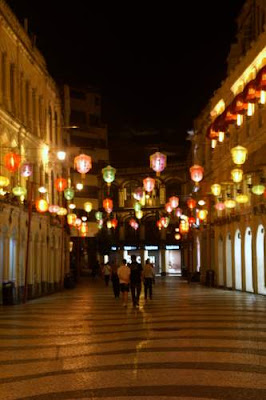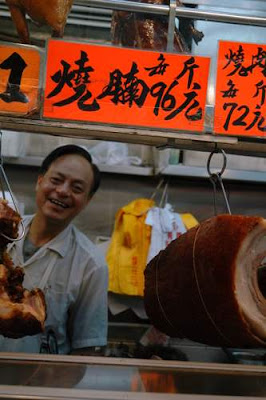
Dear Gentle Reader,
Yesterday was about what might be on the menu for a Hong Kong Thanksgiving, should Hong Kong have a Thanksgiving.
The conclusion which we came to was opium; opium would be the menu, not just on it.
Why?
(Besides the sweetly scented silver derived from the trade, of course.)
Well, lots of great things, like opiate alkaloids, are found in the resin of a few of the plants in the Papaveraceae family.
Today's post continues revolving around Papaver somniferum, the opium poppy.
Opium resin is what you start with.
You get opium resin by lightly slicing the pod of an opium poppy, while it is still on its stalk and attached to the plant, and collecting the white, latex resin that oozes from the cuts.
This resin, collected and dried to a paste, is not a pure, distilled chemical but, rather, a dark smörgåsbord of active ingredients.
The three principal ingredients, from the perspective of a drug taker or a drug seller, are three opiate alkaloids: morphine, narcotin, and codeine.
Morphine, narcotin, and codeine comprise a trinity of soporific delight; a draught of the waters of Lethe without having to get by Charon. Or Cerberus. At least, that is what the seller will tell you...
First though, the naming, as names are so important to poets.
 The principal alkaloid, by quantity and effect, in the sticky opium cocktail, is morphine, C17H19NO3.
The principal alkaloid, by quantity and effect, in the sticky opium cocktail, is morphine, C17H19NO3.
A structural diagram of morphine is over on the right.
I won't trouble you with diagrams for the next two important opiate alkaloids, Narcotin (C22H23NO7) and Codeine (C18H21NO3).
But, for the fancy bio-linguists out there, the black tie IUPAC names for these three compounds are:
Morphine: (5α,6α)-7,8-didehydro-
4,5-epoxy-17-methylmorphinan-3,6-diol
Naroctin: 6,7-dimethoxy-3-(4-methoxy-6-methyl-7,8-dihydro-5H-[1,3]dioxolo[4,5-g]isoquinolin-5-yl)-3H-2-benzofuran-1-one
and
Codeine: (5α,6α)-7,8-didehydro-4,5-epoxy-3-methoxy-17-methylmorphinan-6-ol
If you are going for any kind of poetry creation, however, I'd recommend staying informal.
It's hard to do a haiku, for example, with any of these fancy IUPAC (International Union of Pure and Applied Chemistry) names.
At least, not while sober.
And sober is not what one stays if you smoke opium.
Technically, of course, opium is not smoked; it is not burned, or it shouldn't be burned. That would be a bit of a waste.
Opium, in an opium pipe, is vapourized.
The smoky fumes, cooling in the long, inclined chamber of the pipe before they reach your mouth, are then inhaled.
I've never done it, but the chemistry and physics of the act are obvious from the engravings of opium dens, and from opium pipes which I have seen in both public and private collections.
Yesterday, we went over the numbers as per the quantity of opium that was being shipped to China even before the British had secured Hong Kong as a port.
A port, you see, was handy.
With a port, like Hong Kong, you could load up on opium in Calcutta and come to Hong Kong to revictual. Further, you could make appropriate arrangements to meet your Chinese distributor somewhere in China.
Who wanted to arrive with tens of thousands of pounds of contraband opium and hang out with the pirates while you try to contact your contact... and then receive cash?
That would be a poor risk management plan...
Further, long range meteorological forecasts were not so reliable. Who wanted to arrive and find out that a tropical storm, or, worse, a typhoon was blowing through the region?
No, a port was a good thing.
A port permitted opium sales to skyrocket, which permitted opium production in India to skyrocket, which in turn allowed British Imperial revenues to skyrocket, too.
Don't just take my word for it. Look at this lovely graph.
(y) tons of opium versus (x) date

As usual, the information on all images is found by rolling your mouse pointer over it. But, for speed, the vertical axis measures global opium production measured in tons. The horizontal axis measures years.
So. What did this mean for for China?
By 1906, 27% of the adult, male population of China was addicted to the lovely cocktail of morphine, narcotin, and codeine found in opium.
Of course, by 1906, the British were, mostly, out of this game.
Most of the opium required to supply 27% of the adult, male population of China, in 1906, was home-grown.
(34,000 imperial tons were produced in China, by Chinese, by 1906, versus Chinese consumption of 39,000 imperial tons.)
But the problems of this many addicts, in China, led to massive social and economic unrest.
By 1911, the unrest would be political, too, as the Qing Dynasty would be overthrown and, in 1912, Generalissimo Chiang Kai Shek would become the President of the Republic of China.
Folks across Asia have bad, and recent, memories of rampant drug addictions.
So, generally speaking, there are significant penalties for being caught with drugs. Especially at entry and exit points...airports or seaports.
(The pessimist would say this is to help safeguard local monopolies in distribution, export, and import. I, of course, would never think such thoughts.)
And here is where the story of the day comes in.
Back when your humble scribe used to live in Taiwan, a very long time ago, an English chap came to Taiwan on business.
He knew about the concept of giving gifts, to help generate better relationships with people.
So he brought a dried flower arrangement.
(I know. I don't think he knew much about giving gifts, or relationships. But, I guess, he tried. Or maybe his secretary hated him.)
So what?
That arrangement contained a dried poppy.
Not, I hasten to add, an opium poppy, Papaver somniferum.
Just a regular, run of the mill poppy.
...
It took weeks for him to be sprung from prison on Green Island.
Green Island has a prison and not much else.
This is a prison where, then at least, your family and friends had to send you food if you wanted to maintain a vaguely appropriate caloric intake.
Or, if you wanted to try to bribe the giant rats so that they wouldn't nibble on you nose or gnaw on your shins when exhaustion overcame you.
Now there was a man who, I am sure, would have wanted a long, deep draught from the waters of Lethe, or from our unholy trinity of opiate alkaloids, when he was finally released.
Asia.
Don't mess around with things you shouldn't.
And be thankful for everything that you do enjoy.
But, try to not need opium.
Things could always be worse.
Tschuess,
Chris
P.S. I am thankful that you are reading. Go figure. That surprises me every day.
P.P.S. Why does your humble scribe know anything about opium?
I have taken on the alter-ego of an Akkadian scribe...
And Sumerian pottery was being decorated with opium poppies before cuneiform was fully developed as a script for language, not just for accounting for profit and loss.
It's in my collective memory, if not my blood (thank goodness). Take care.
For music, today, Karl Marx thought this stuff was the opiate of the masses; I am quite happy to imbibe an opiate like this.
This is the first movement in an Armenian liturgical concert.
Click to hear 'Where are you, oh Mother' by Isabel Bayrakdarian
Amazon.com iTunes
Tschuess,
Chris
 Dear Gentle Reader,
Dear Gentle Reader,















